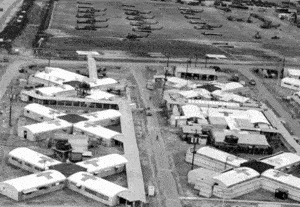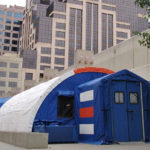Field Hospitals Throughout History
Mobile hospitals have been a crucial part of every war in history. From ancient battles and sieges to the combat support hospitals that followed troops throughout Europe during World War II, mobile field hospitals and evacuation hospitals have saved countless lives.
In the days before antibiotics, field hospitals were the site of agony and death for most patients as overwhelmed and under-equipped physicians did the best they could to make the wounded as comfortable as possible in their final hours.
In the past 100 years, however, radical discoveries, improvements, and innovations in medicine — such as the 1929 discovery of penicillin — have transformed field hospitals into life-saving, effective treatment facilities.
Developments in the design and functionality of these facilities have also made them more portable, equipped for a wider range of uses, and safer for sensitive treatment procedures.
Field Hospitals During the Civil War
Throughout the Civil War, the public perception of medical facilities and staff was quite negative,
perpetuated by disorganization and inadequacies on both sides.
Field hospitals were horrific, bloody places where most severely wounded soldiers expected only to find some small comfort as they died. The ignorance of bacteria resulted in rampant infections — even after successful life-saving procedures.
Despite these issues, however, both the Union and Confederate medical departments were able to improve the standard of care provided to sick and wounded soldiers rather quickly, and the Union even developed hospital trains to quickly and safely transport wounded and sick to more established hospitals for treatment.
[Related: BLU-MED Medical Facilities and Mobile Field Hospitals vs. Expandable Hospital Containers]
Field Hospitals During World War II
During World War II, field hospitals typically had 400 beds, while evacuation hospitals had a capacity for 400 or 750 beds.
Historically, they “arrived within a few days of an invasion and followed the army, staying about thirty miles behind the front. They were close enough to treat patients quickly and send them back to the front quickly as well. These hospitals relied on mobility.”
Field hospitals were kept closer to the front and evacuation hospitals were closer to the rear in the European Theater, while they were used interchangeably in the Mediterranean Theater. In both regions, “leapfrogging” (Hospital A would pass Hospital B, and then vice versa) allowed the front to advance with minimal frequency of hospital moves.
Beyond the simple mobile field hospitals that had been in use for centuries, portable surgical hospitals designed for more sensitive medical care were developed midway into World War II and adopted by the U.S. Army in 1943. It was a compromise solution to meet a critical need, and as such, these units had several key shortcomings.
[Related: Setting Up a Trauma Center]
Modern Field Hospitals
Today’s mobile field hospitals for surgery and sensitive medical treatment have radically improved over the 1943 version, resolving the early hospitals’ key weaknesses:
- While the original hospitals lacked the equipment needed for definitive surgery in order to maintain their portability, modern units are manufactured with lightweight materials and equipment.
- The earliest portable surgical hospitals had insufficient bed capacity for postoperative patients. Today’s structures can be expanded with additional systems for more capacity.
- The old version was never entirely self-sufficient. Most manufacturers of today’s mobile field hospitals offer add-on systems for power generation and distribution, electricity and lighting, environmental control and more for fully standalone hospitals.
In light of modern developments in medicine, medical technologies, and even building innovations, today’s mobile field hospitals are ideally suited for a wide range of needs for the preservation of human life.
Their advantages over traditional hospitals, including portability, longevity, versatility, customization, and standalone capacity, make these units highly necessary for effective disaster response and combat support.
Contact us at BLU-MED Response Systems® for more information about our modern mobile field hospitals and how they can meet your needs.


